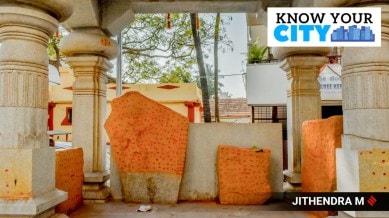Stay updated with the latest - Click here to follow us on Instagram
Know Your City: Stone commemorating an ancient hero of Hebbal, over 12 centuries later
An inscription at the Nageshvara Temple in Begur refers to a battle fought in Bengaluru sometime around 890 AD.

When one thinks of the earliest residents of Bengaluru, the name of Kempe Gowda pops up immediately. While he might be the first one to build a large settlement in the area, it had already long been host to many smaller towns and villages.
One of the oldest settlements from the era is Hebbal — though its ancient residents did not know it by that name. One of the older attestations of the time before Kempe Gowda is an inscription at the Nageshvara Temple in Begur, which refers to a battle fought in Bengaluru sometime around 890 AD.
monthly limit of free stories.
with an Express account.
The stone, which is currently displayed under a crowdfunded mandapa in Hebbal along with three younger inscriptions found near it, is a hero stone commemorating a local resident, Kittaya. According to the inscription on the stone, sometime around 750 AD, during the reign of King Sripurusha of the Ganga Dynasty, which ruled the region, the Rashtrakutas attacked the village, intending to raze it to the ground. Kittaya had died while repulsing the invaders, and the stone was installed in his memory.
Just a few years ago, the stone was found almost abandoned. PL Udaya Kumar of the Inscriptions 3D Digital Conservation project said, “It was in a roadside pit. The first time I saw it was in 2017… At that time it was basically with the three other stones. I had gone there looking for a few documented inscriptions, including one from the 1600s. The hero stone, which was not documented till then, was half buried, with only the sculpture portion visible.”
At the time, residents were not keen on having the stones moved as they had become objects of worship during Sankranti, and they believed the stones should not be touched or moved. But at other times of the year, the section of the roadside was open to garbage and even betel stains on the ancient stones.
In 2018, in the run-up to the elections at the time, local authorities intended to fill up the pit and level the road. A man from the area had noticed this, reached out to his friends, and persuaded residents to allow them to move the stone out of harm’s way.
Udaya Kumar said, “The boys called me since they knew I had traced one of the stones from the 16th century… They found writing on the Kittaya stone and asked me to send the text of a 13th-century inscription that I was also looking for, as they thought it might be the stone. They were unable to read it, and mistook it for Tamil, as 8th century Kannada is not recognisable and can look like Tamil to an untrained eye”. He added, “They reached out to PV Krishnamurthy, an epigraphist, who examined the inscription over a couple of months.”
Krishnamurthy found that the stone was possibly the oldest inscription in Bengaluru. After this, the mandapa that currently houses the Kittaya inscriptions and the other stones was crowdfunded and built.
Another interesting piece of information gleaned from the stone is about the name that Hebbal was known by at the time – Perbolal. According to Udaya Kumar, the name starts with the sound “p” is an archaic feature of the ancient Dravidian language which was later divided into Tamil, Telugu, Kannada, and other Dravidian languages such as Tulu. However, while this feature survived in most other Dravidian languages, it did not in Kannada, and became an “h” sound. For example, while the Tamil word for tiger is puli, the Kannada word is huli.
Udaya Kumar says, “Over time Perbolal became Pebbol, which became Pebbal and then Hebbal today. We know this because of other inscriptions which give us the names.”